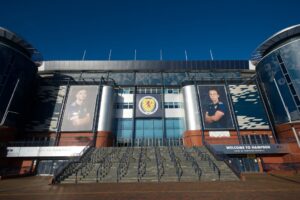Workforce
Diversity
Click here to go to the Strategy Hub
Workforce for the Future: The Hollybrook Scottish Cup Gallery Project
A project in partnership with Scottish Football Museum, Museums Galleries Scotland, Developing the Young Workforce and Hollybrook Academy.

The Project
Pupils from the Hollybrook Academy attended the Scottish Football Museum over ten sessions covering all aspects of the museum and heritage environment. The project was split into three sections:
- Meeting Museums: Working with The Scottish Football Museum’s Curatorial Assistant the pupils explored job roles and the range of skills that are useful in the workplace, as well as the role of Curator and Visitor Attraction Manager.
- Objects & Interpretation: Pupils looked at the variety of objects within a museum, how to care for these objects and share their unique stories. Pupils were asked to bring in a ‘favourite thing’. They brought in comic books, toy cars, a journalling diary, and of course a football. The pupils then researched and photographed their favourite thing and created their very own ‘mini museum’ for visitors in the museum, they also took them back to school to present to their peers.
- Scottish Cup Gallery Creation: The pupils explored the extensive trophy collections within the museum, looking for inspiration to design their own winning trophy. The pupils’ designs were then digitised by a local graphic designer to create a ‘Design your own Trophy’ interactive for the newly refurbished ‘Scottish Cup Gallery’ Exhibition.
I liked seeing all of the different trophies in the museum, and I really liked learning about the different jobs in the museum, like the tour guides and the curator.
Pupil, Hollybrook Academy
Challenges and successes
- Working with the Hollybrook Academy has allowed the pupils and the staff within the Scottish Football Museum to create a close working relationship that can be built on and developed into future projects.
- The museum has been able to explore the possibility of delivering educational workshops in the future with the created learning resources.
- There were difficulties in finding time and budget to ensure that learners with special educational needs and disabilities can access and benefit fully.
- A further challenge is capturing the value to pupils, teachers, families, professionals, and localities in ways that articulate museums’ important and distinct role in the local educational landscape.
- It was a challenge to keep in contact with individuals when working through the project, as people have different workloads and working hours. Organising the initial project has been a challenge.
Impact
- The pupils learnt about the diversity of job roles in the heritage sector, and The Scottish Football Museum has been able to build a relationship with the local school, creating the possibility of future partnerships.
- The Hollybrook pupils have developed literacy, numeracy, critical investigation, comprehension, and creativity. Working together and individually, the pupils have discovered the museum’s collections and expanded their knowledge of the history of the collection.
- The Hollybrook pupils have developed their confidence, skills, and aspirations as they discover the museum as a place of work whilst increasing their employability skills.
- Through this project, the Scottish Football Museum has strengthened its relationship with Hollybrook Academy. We hope to continue this connection in our future work and expand our outreach further to similar schools around Glasgow, creating new partnerships and opportunities with different people, museums, and schools that in turn will benefit all parties in distinct and unique ways.
Guidance
- Using the MGS evaluation resources allowed us to conduct two separate evaluation sessions at the beginning and end of the project. This helped us measure the children’s gained knowledge throughout the ten sessions and the topics they found most enjoyable during their time with us.
- We found that when working with pupils with additional support needs, breaking up the sessions into smaller fragments of time allowed us to support the children effectively. Having smaller group teaching and learning strategies can help increase student engagement, retention of knowledge, self-directed learning, communication skills, teamwork ability, and peer discussion.
- Clear communication and concise language when interacting with children is invaluable. Adapt your communication style based on their individual needs, such as using visual aids, sign language, or augmentative and alternative.
Additional information
Project contact is Megan Stamper, Curatorial Assistant at the Scottish Football Museum. Megan.Stamper@scottishfootballmuseum.org.uk or 0141 620 4086